Unit 3 Getting Together期末复习课件(共30张PPT)
文档属性
| 名称 | Unit 3 Getting Together期末复习课件(共30张PPT) | 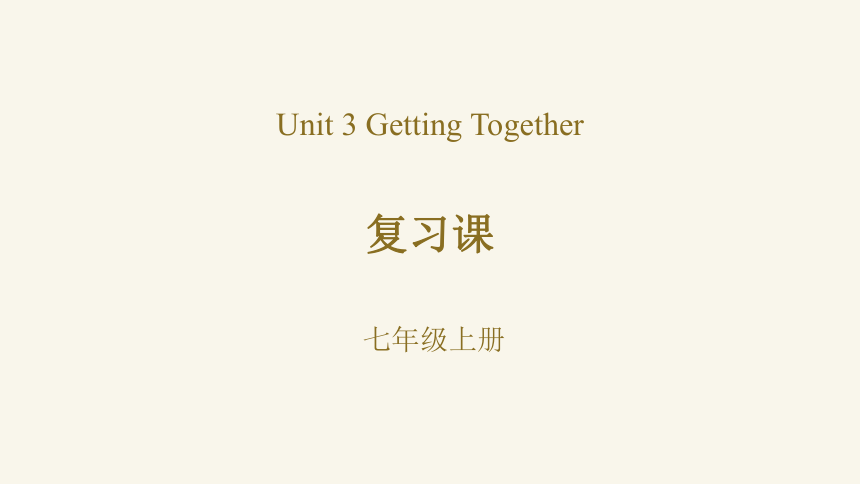 | |
| 格式 | zip | ||
| 文件大小 | 135.0KB | ||
| 资源类型 | 教案 | ||
| 版本资源 | 仁爱科普版 | ||
| 科目 | 英语 | ||
| 更新时间 | 2021-12-08 06:57:08 | ||
图片预览



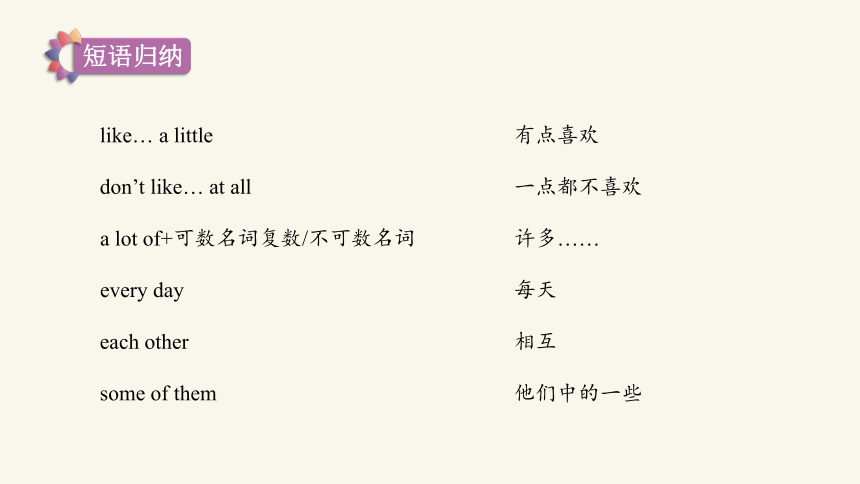
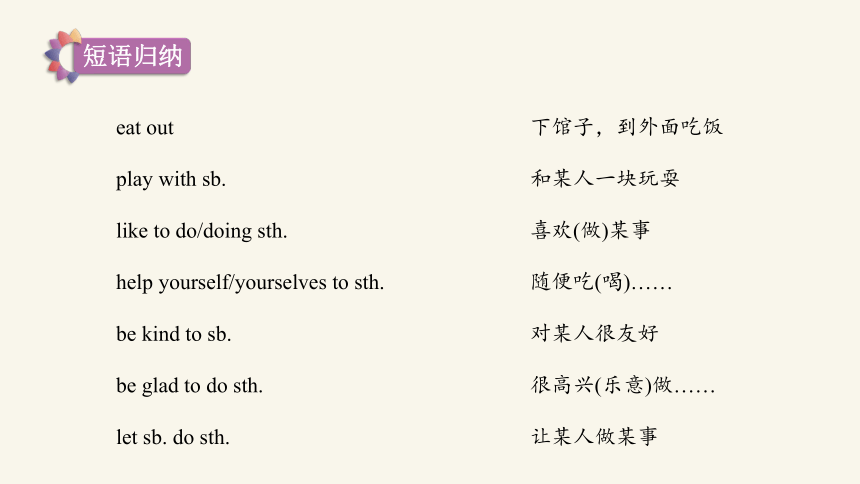
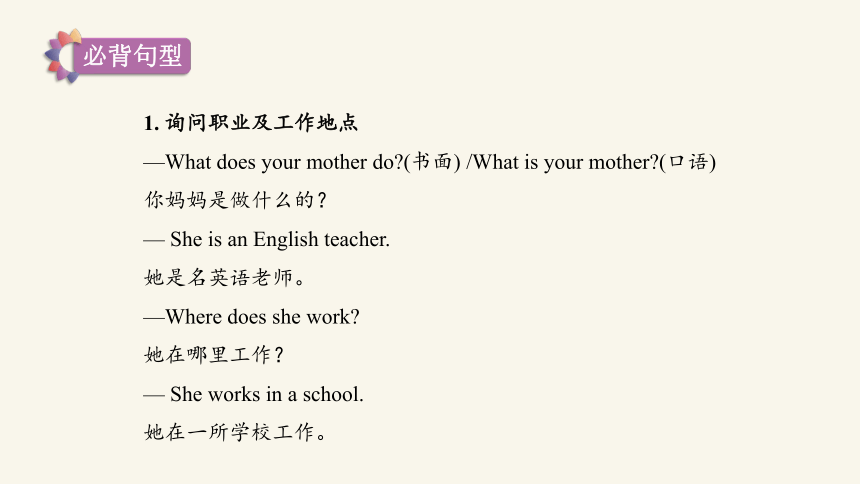
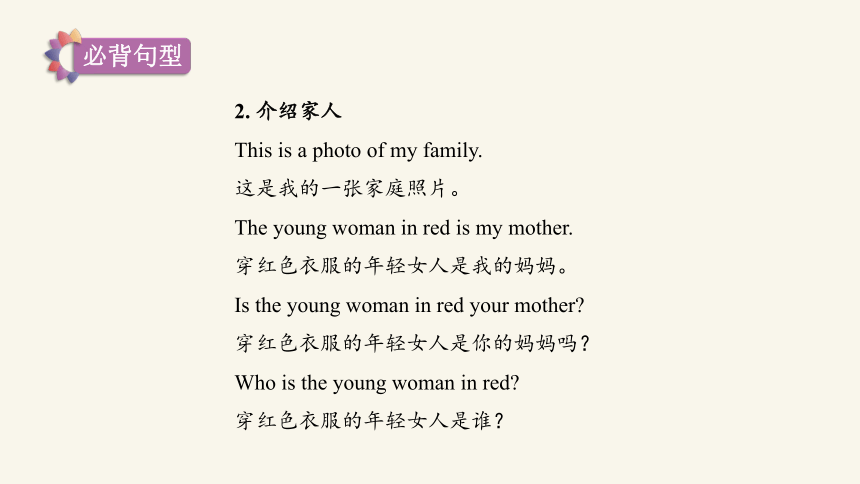



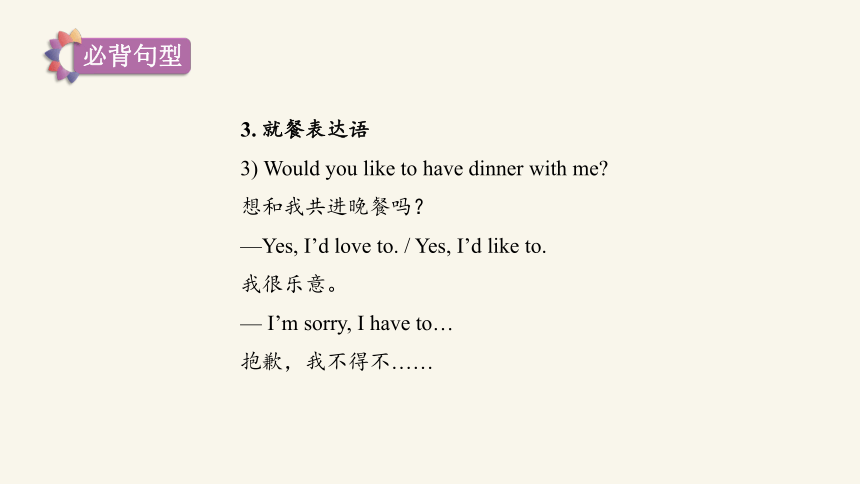
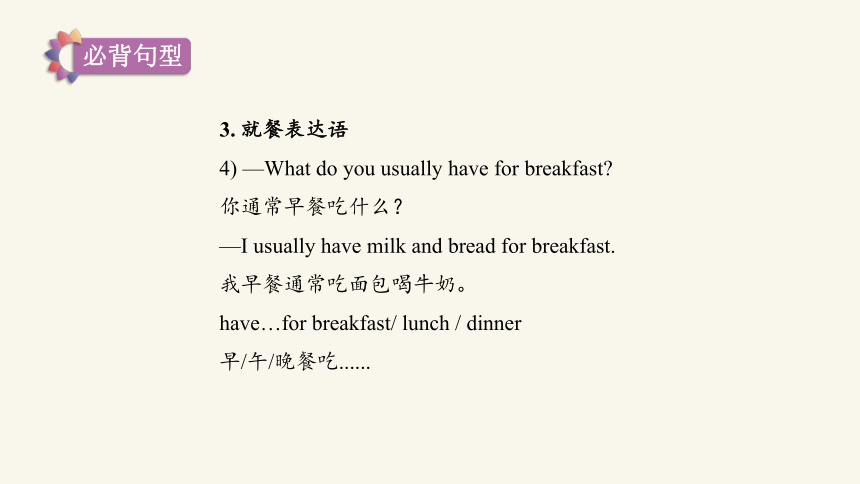
文档简介
(共30张PPT)
Unit 3 Getting Together
复习课
七年级上册
Could you please + 动词原形……?
tell sb. sth. = tell sth. to sb.
tell sb. about sth.
help sb. do sth.= help sb. with sth.
want to do sth.= would like to do sth.
want sth. = would like sth.
短语归纳
用来表示委婉的请求
告诉某人某事
告诉某人关于某事
在某方面帮助某人,帮助某人做某事
想要做某事
想要某物
want sb. to do sth.
show sth. to sb.= show sb. sth.
live in+ 地点
live with + sb.
know a lot about…
短语归纳
想要某人做某事
把某物展示给某人看
居住在某地
和某人住
知道许多关于……的事
like… a little
don’t like… at all
a lot of+可数名词复数/不可数名词
every day
each other
some of them
短语归纳
有点喜欢
一点都不喜欢
许多……
每天
相互
他们中的一些
eat out
play with sb.
like to do/doing sth.
help yourself/yourselves to sth.
be kind to sb.
be glad to do sth.
let sb. do sth.
短语归纳
下馆子,到外面吃饭
和某人一块玩耍
喜欢(做)某事
随便吃(喝)……
对某人很友好
很高兴(乐意)做……
让某人做某事
1. 询问职业及工作地点
—What does your mother do (书面) /What is your mother (口语)
你妈妈是做什么的?
— She is an English teacher.
她是名英语老师。
—Where does she work
她在哪里工作?
— She works in a school.
她在一所学校工作。
必背句型
2. 介绍家人
This is a photo of my family.
这是我的一张家庭照片。
The young woman in red is my mother.
穿红色衣服的年轻女人是我的妈妈。
Is the young woman in red your mother
穿红色衣服的年轻女人是你的妈妈吗?
Who is the young woman in red
穿红色衣服的年轻女人是谁?
必背句型
2. 介绍家人
My grandparents, my cousin and I are on the sofa.
我的爷爷奶奶,我的表妹和我在沙发上。
I have a big family.
我有一个大家庭。
I love my family.
我爱我的家。
必背句型
3. 就餐表达语
1) —Would you like something to drink
想不想喝些东西?
—Yes, a glass of apple juice, please. / No, thanks.
一杯苹果汁。/不了,谢谢。
something to drink
一些喝的东西
something to eat
一些吃的东西
必背句型
3. 就餐表达语
2) —What would you like to have / eat / drink
你想吃(喝)些什么?
—I’d like some rice and chicken. / Let me see.
我想要米饭和鸡肉。/我想想看。
必背句型
3. 就餐表达语
3) Would you like to have dinner with me
想和我共进晚餐吗?
—Yes, I’d love to. / Yes, I’d like to.
我很乐意。
— I’m sorry, I have to…
抱歉,我不得不……
必背句型
3. 就餐表达语
4) —What do you usually have for breakfast
你通常早餐吃什么?
—I usually have milk and bread for breakfast.
我早餐通常吃面包喝牛奶。
have…for breakfast/ lunch / dinner
早/午/晚餐吃......
必背句型
3. 就餐表达语
5) —May I take your order, sir
请问,要点菜了吗?
—Fish with vegetables and rice, please.
鱼和蔬菜还有米饭。
6) May I help you = Can I help you =What can I do for you
请问要吃/喝/买些什么?
必背句型
4. 委婉地请求、提建议的五种表达
1)Would you like sth. / to do…
你愿意/想……?
2) What / How about sth. / doing…
……怎么样?
3)Why not do…
为什么不……?
必背句型
4. 委婉地请求、提建议的五种表达
4)Let’s do…!
让我们干……吧!
5)Why don’t you do…
为什么不……?
肯定回答:Yes, I’d like/love to. /Good idea. /OK. / All right./ I’d love that.
否定回答: No, thanks. / I’m sorry I can’t, I have to do…/ I’d like that, but I’m sorry I have no time.
必背句型
1. 人称代词的主格与宾格
主格在句子中充当主语,放在动词之前;宾格放在动词之后构成动宾短语,放在介词之后构成介宾短语。
—Do you know them
— Yes. They are my new classmates.
语法点
2. 可数名词与不可数名词
(1)可数名词:可以用数目来计数的名词,有单数和复数之分。
如:banana, egg, apple, orange, noodles, vegetable, hamburger等。
(2)不可数名词:不能用具体的数目来表示,前面不能加a/an,没有复数形式。
如:milk, chicken, bread, Coke, coffee, rice, juice, fish, tea, water, chocolate等。
语法点
2. 可数名词与不可数名词
(3)不可数名词若要表示数量,可用:数词+量词+ of + 不可数名词。
如:a glass of milk 一杯牛奶;ten bottles of apple juice十瓶橙汁;ten loaves of bread 十条面包
(4)some/ a lot of +可数名词的复数/ 不可数名词
many +可数名词的复数
much +不可数名词
语法点
【书信的格式】
1. 称呼:顶格写,常用Dear… 开头,表示亲切、客套,后面用逗号。
2. 正文:从称呼的下一行开始写,开头空两格。
3. 结束语:正文下面的客套话,写在右下角,首字母大写,末尾用逗号,常用Yours。
4. 签名:指写信人的签名,写在结束语的下面。
语法点
good和well两者都意为“好”,但good是形容词,只能放在名词前作定语或放在系动词后作表语。
e.g.
Linda is a good girl.
The food smells good.
词汇辨析
good和well
say指说的具体内容;
speak指说某种语言,强调讲话的能力或说的方式。
e.g.
She says she likes apples.
She speaks Chinese well.
say 和 speak
词汇辨析
“Glad to meet you. ”,“Nice to meet you. ”和“Nice to see you. ”
这三句话意思相同,都是“很高兴见到你。”
就正式程度而言,“Nice to meet you. ”是三句中最正式的,
它用于陌生人首次见面时打招呼。
相比之下,“Glad to meet you. ”和“Nice to seeyou. ”则较随意,
用于熟人、朋友之间的见面。
词汇辨析
at, in两个介词接地点时的区别:
at常表示的位置是某一个具体地点,一般用来指比较小的地方,如:车站、村庄、建筑物、城镇等。
e.g.
at the school gate
in一般用来指大地方,如:大城市、省、行政区、国家等。e.g.
in Shanghai
in the USA
词汇辨析
in 介词,意为“穿着,戴着”。
强调 “穿”的状态,可用于穿鞋、戴帽、穿衣服等。
e.g.
The boy in a white shirt is my brother.
put on 也有“穿、戴”之意。
与in的区别在于:put on 为动词词组,反义词:take off;
强调“穿”的动作,可用于穿鞋、戴帽、穿衣服等。
e.g.
I put on my coat and go to school.
词汇辨析
family和home
family
意为“家,家庭;家人”。着重指家庭、家庭成员或家中人口。
home
意为“家”。指家人共同生活居住的地方。特别强调家里的氛围和环境,不含有建筑的意思。
词汇辨析
佳作赏析
关于书信的写作
Dear David,
I’m glad to get to know you. My name is Li Hua. I come from Shandong, China. I’m twelve. I’m a student in No. 1 High School. My favorite food is rice and vegetables. I have a happy family. My father is a doctor. My mother is a nurse. They work in the same hospital. Could you tell me something about your family
Yours,
Li Hua
同步练习
根据句意及首字母提示补全单词。
1. Could you please tell me s__________ about your family
2. Jimmy likes chicken very much, but he doesn’t like fish at a__________.
3. —What about some fish
—It’s a good i__________.
4. His father’s father and mother are his g__________.
5. Liu Han is a cook, and he works in a r__________.
omething
ll
dea
randparents
estaurant
同步练习
1.格林先生是英国人,但他对中国很了解。
Mr. Green is English, but he __________ a lot __________ China.
2. 你能把照片展示给我们看吗?
—Could you __________ your photos to __________
3. 你愿意和我一起去动物园吗?
—__________ __________ __________ to go to the zoo with me
4.——穿红色衣服的那位女士是谁?
—Who is the woman __________ __________
5.我们是朋友,所以我们经常互相帮助。
We are friends, so we often __________ __________ __________.
knows
about
show
us
Would you like
in red
help each other
同步练习
Look! This is my friend Yukio. He comes from Japan. Now he 1 in Beijing with his parents. He is a 2 of a junior high school in Beijing. He 3 English well, but his Chinese is not 4 So I often help him 5 it after school. In the morning, he usually has a 6 of milk and some bread for breakfast. He has lunch at school and dinner at home. His father is a 7 He drives a bus in our school. His mother is a teacher. She 8 English in our school. They are 9 to the students. So all the students like 10 very much. Yukio has a happy family.
1. . 2. . 3. . 4. .5. .
6. . 7. . 8. . 9. .10. .
lives
student
speaks
good
with
glass
driver
teaches
kind
them
Unit 3 Getting Together
复习课
七年级上册
Could you please + 动词原形……?
tell sb. sth. = tell sth. to sb.
tell sb. about sth.
help sb. do sth.= help sb. with sth.
want to do sth.= would like to do sth.
want sth. = would like sth.
短语归纳
用来表示委婉的请求
告诉某人某事
告诉某人关于某事
在某方面帮助某人,帮助某人做某事
想要做某事
想要某物
want sb. to do sth.
show sth. to sb.= show sb. sth.
live in+ 地点
live with + sb.
know a lot about…
短语归纳
想要某人做某事
把某物展示给某人看
居住在某地
和某人住
知道许多关于……的事
like… a little
don’t like… at all
a lot of+可数名词复数/不可数名词
every day
each other
some of them
短语归纳
有点喜欢
一点都不喜欢
许多……
每天
相互
他们中的一些
eat out
play with sb.
like to do/doing sth.
help yourself/yourselves to sth.
be kind to sb.
be glad to do sth.
let sb. do sth.
短语归纳
下馆子,到外面吃饭
和某人一块玩耍
喜欢(做)某事
随便吃(喝)……
对某人很友好
很高兴(乐意)做……
让某人做某事
1. 询问职业及工作地点
—What does your mother do (书面) /What is your mother (口语)
你妈妈是做什么的?
— She is an English teacher.
她是名英语老师。
—Where does she work
她在哪里工作?
— She works in a school.
她在一所学校工作。
必背句型
2. 介绍家人
This is a photo of my family.
这是我的一张家庭照片。
The young woman in red is my mother.
穿红色衣服的年轻女人是我的妈妈。
Is the young woman in red your mother
穿红色衣服的年轻女人是你的妈妈吗?
Who is the young woman in red
穿红色衣服的年轻女人是谁?
必背句型
2. 介绍家人
My grandparents, my cousin and I are on the sofa.
我的爷爷奶奶,我的表妹和我在沙发上。
I have a big family.
我有一个大家庭。
I love my family.
我爱我的家。
必背句型
3. 就餐表达语
1) —Would you like something to drink
想不想喝些东西?
—Yes, a glass of apple juice, please. / No, thanks.
一杯苹果汁。/不了,谢谢。
something to drink
一些喝的东西
something to eat
一些吃的东西
必背句型
3. 就餐表达语
2) —What would you like to have / eat / drink
你想吃(喝)些什么?
—I’d like some rice and chicken. / Let me see.
我想要米饭和鸡肉。/我想想看。
必背句型
3. 就餐表达语
3) Would you like to have dinner with me
想和我共进晚餐吗?
—Yes, I’d love to. / Yes, I’d like to.
我很乐意。
— I’m sorry, I have to…
抱歉,我不得不……
必背句型
3. 就餐表达语
4) —What do you usually have for breakfast
你通常早餐吃什么?
—I usually have milk and bread for breakfast.
我早餐通常吃面包喝牛奶。
have…for breakfast/ lunch / dinner
早/午/晚餐吃......
必背句型
3. 就餐表达语
5) —May I take your order, sir
请问,要点菜了吗?
—Fish with vegetables and rice, please.
鱼和蔬菜还有米饭。
6) May I help you = Can I help you =What can I do for you
请问要吃/喝/买些什么?
必背句型
4. 委婉地请求、提建议的五种表达
1)Would you like sth. / to do…
你愿意/想……?
2) What / How about sth. / doing…
……怎么样?
3)Why not do…
为什么不……?
必背句型
4. 委婉地请求、提建议的五种表达
4)Let’s do…!
让我们干……吧!
5)Why don’t you do…
为什么不……?
肯定回答:Yes, I’d like/love to. /Good idea. /OK. / All right./ I’d love that.
否定回答: No, thanks. / I’m sorry I can’t, I have to do…/ I’d like that, but I’m sorry I have no time.
必背句型
1. 人称代词的主格与宾格
主格在句子中充当主语,放在动词之前;宾格放在动词之后构成动宾短语,放在介词之后构成介宾短语。
—Do you know them
— Yes. They are my new classmates.
语法点
2. 可数名词与不可数名词
(1)可数名词:可以用数目来计数的名词,有单数和复数之分。
如:banana, egg, apple, orange, noodles, vegetable, hamburger等。
(2)不可数名词:不能用具体的数目来表示,前面不能加a/an,没有复数形式。
如:milk, chicken, bread, Coke, coffee, rice, juice, fish, tea, water, chocolate等。
语法点
2. 可数名词与不可数名词
(3)不可数名词若要表示数量,可用:数词+量词+ of + 不可数名词。
如:a glass of milk 一杯牛奶;ten bottles of apple juice十瓶橙汁;ten loaves of bread 十条面包
(4)some/ a lot of +可数名词的复数/ 不可数名词
many +可数名词的复数
much +不可数名词
语法点
【书信的格式】
1. 称呼:顶格写,常用Dear… 开头,表示亲切、客套,后面用逗号。
2. 正文:从称呼的下一行开始写,开头空两格。
3. 结束语:正文下面的客套话,写在右下角,首字母大写,末尾用逗号,常用Yours。
4. 签名:指写信人的签名,写在结束语的下面。
语法点
good和well两者都意为“好”,但good是形容词,只能放在名词前作定语或放在系动词后作表语。
e.g.
Linda is a good girl.
The food smells good.
词汇辨析
good和well
say指说的具体内容;
speak指说某种语言,强调讲话的能力或说的方式。
e.g.
She says she likes apples.
She speaks Chinese well.
say 和 speak
词汇辨析
“Glad to meet you. ”,“Nice to meet you. ”和“Nice to see you. ”
这三句话意思相同,都是“很高兴见到你。”
就正式程度而言,“Nice to meet you. ”是三句中最正式的,
它用于陌生人首次见面时打招呼。
相比之下,“Glad to meet you. ”和“Nice to seeyou. ”则较随意,
用于熟人、朋友之间的见面。
词汇辨析
at, in两个介词接地点时的区别:
at常表示的位置是某一个具体地点,一般用来指比较小的地方,如:车站、村庄、建筑物、城镇等。
e.g.
at the school gate
in一般用来指大地方,如:大城市、省、行政区、国家等。e.g.
in Shanghai
in the USA
词汇辨析
in 介词,意为“穿着,戴着”。
强调 “穿”的状态,可用于穿鞋、戴帽、穿衣服等。
e.g.
The boy in a white shirt is my brother.
put on 也有“穿、戴”之意。
与in的区别在于:put on 为动词词组,反义词:take off;
强调“穿”的动作,可用于穿鞋、戴帽、穿衣服等。
e.g.
I put on my coat and go to school.
词汇辨析
family和home
family
意为“家,家庭;家人”。着重指家庭、家庭成员或家中人口。
home
意为“家”。指家人共同生活居住的地方。特别强调家里的氛围和环境,不含有建筑的意思。
词汇辨析
佳作赏析
关于书信的写作
Dear David,
I’m glad to get to know you. My name is Li Hua. I come from Shandong, China. I’m twelve. I’m a student in No. 1 High School. My favorite food is rice and vegetables. I have a happy family. My father is a doctor. My mother is a nurse. They work in the same hospital. Could you tell me something about your family
Yours,
Li Hua
同步练习
根据句意及首字母提示补全单词。
1. Could you please tell me s__________ about your family
2. Jimmy likes chicken very much, but he doesn’t like fish at a__________.
3. —What about some fish
—It’s a good i__________.
4. His father’s father and mother are his g__________.
5. Liu Han is a cook, and he works in a r__________.
omething
ll
dea
randparents
estaurant
同步练习
1.格林先生是英国人,但他对中国很了解。
Mr. Green is English, but he __________ a lot __________ China.
2. 你能把照片展示给我们看吗?
—Could you __________ your photos to __________
3. 你愿意和我一起去动物园吗?
—__________ __________ __________ to go to the zoo with me
4.——穿红色衣服的那位女士是谁?
—Who is the woman __________ __________
5.我们是朋友,所以我们经常互相帮助。
We are friends, so we often __________ __________ __________.
knows
about
show
us
Would you like
in red
help each other
同步练习
Look! This is my friend Yukio. He comes from Japan. Now he 1 in Beijing with his parents. He is a 2 of a junior high school in Beijing. He 3 English well, but his Chinese is not 4 So I often help him 5 it after school. In the morning, he usually has a 6 of milk and some bread for breakfast. He has lunch at school and dinner at home. His father is a 7 He drives a bus in our school. His mother is a teacher. She 8 English in our school. They are 9 to the students. So all the students like 10 very much. Yukio has a happy family.
1. . 2. . 3. . 4. .5. .
6. . 7. . 8. . 9. .10. .
lives
student
speaks
good
with
glass
driver
teaches
kind
them
同课章节目录
- Unit 1 Making new friends
- Topic 1 Welcome to China!
- Topic 2 Where are you from?
- Topic 3 How old are you?
- Unit 2 Looking different
- Topic 1 I have a small nose
- Topic 2 What does she look like?
- Topic 3 Whose jacket is this?
- Unit 3 Getting togethe
- Topic 1 Does he speak Chinese?
- Topic 2 What do your parents do?
- Topic 3 What would you like to drink?
- Unit 4 Having fun
- Topic 1 What can I do for you?
- Topic 2 Would you like to cook with us?
- Topic 3 What time is it now?
